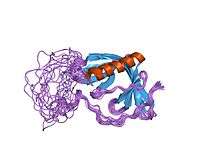EVH1 domain
The EVH1 domain (also known as the WH1, RanBP1-WASP, or enabled/VASP homology 1 domain) is an evolutionary conserved protein domain.
| EVH1 | |||||||||
|---|---|---|---|---|---|---|---|---|---|
 structure of the n-wasp evh1 domain-wip complex | |||||||||
| Identifiers | |||||||||
| Symbol | EVH1 | ||||||||
| Pfam | PF00568 | ||||||||
| Pfam clan | CL0266 | ||||||||
| InterPro | IPR000697 | ||||||||
| SMART | WH1 | ||||||||
| SCOPe | 1evh / SUPFAM | ||||||||
| CDD | cd00837 | ||||||||
| |||||||||
The EVH1 domain is found in multi-domain Ena/Vasp homology proteins implicated in a diverse range of signalling, nuclear transport and cytoskeletal events. This domain of around 115 amino acids is present in species ranging from yeast to mammals. Many EVH1-containing proteins associate with actin-based structures and play a role in cytoskeletal organisation. EVH1 domains recognise and bind the proline-rich motif FPPPP with low-affinity, further interactions then form between flanking residues.[1][2][3][4]
WASP family proteins contain an EVH1 (WH1) in their N-terminus which bind proline-rich sequences in the WASP interacting protein. Proteins of the RanBP1 family contain a WH1 domain in their N-terminal region, which seems to bind a different sequence motif present in the C-terminal part of RanGTP protein.[5][6]
Tertiary structure of the WH1 domain of the Mena protein revealed structure similarities with the pleckstrin (PH) domain. The overall fold consists of a compact parallel beta-sandwich, closed along one edge by a long alpha helix. A highly conserved cluster of three surface-exposed aromatic side-chains forms the recognition site for the molecule's target ligands.[7]
Examples
Human genes encoding proteins containing the EVH1 domain include:
References
- Ball LJ, Jarchau T, Oschkinat H, Walter U (February 2002). "EVH1 domains: structure, function and interactions". FEBS Lett. 513 (1): 45–52. doi:10.1016/S0014-5793(01)03291-4. PMID 11911879.
- Niebuhr K, Ebel F, Frank R, Reinhard M, Domann E, Carl UD, Walter U, Gertler FB, Wehland J, Chakraborty T (September 1997). "A novel proline-rich motif present in ActA of Listeria monocytogenes and cytoskeletal proteins is the ligand for the EVH1 domain, a protein module present in the Ena/VASP family". EMBO J. 16 (17): 5433–44. doi:10.1093/emboj/16.17.5433. PMC 1170174. PMID 9312002.
- Pawson T. "EVH1 Domain". The Pawson Lab. Retrieved 2011-06-09.
- PDB: 1QC6; Fedorov AA, Fedorov E, Gertler F, Almo SC (July 1999). "Structure of EVH1, a novel proline-rich ligand-binding module involved in cytoskeletal dynamics and neural function". Nat. Struct. Biol. 6 (7): 661–5. doi:10.1038/10717. PMID 10404224.
- Callebaut I, Cossart P, Dehoux P (December 1998). "EVH1/WH1 domains of VASP and WASP proteins belong to a large family including Ran-binding domains of the RanBP1 family". FEBS Lett. 441 (2): 181–5. doi:10.1016/S0014-5793(98)01541-5. PMID 9883880.
- Beddow AL, Richards SA, Orem NR, Macara IG (April 1995). "The Ran/TC4 GTPase-binding domain: identification by expression cloning and characterization of a conserved sequence motif". Proc. Natl. Acad. Sci. U.S.A. 92 (8): 3328–32. doi:10.1073/pnas.92.8.3328. PMC 42159. PMID 7724562.
- Prehoda KE, Lee DJ, Lim WA (May 1999). "Structure of the enabled/VASP homology 1 domain-peptide complex: a key component in the spatial control of actin assembly". Cell. 97 (4): 471–80. doi:10.1016/S0092-8674(00)80757-6. PMID 10338211.
External links
- Eukaryotic Linear Motif resource motif class LIG_EVH1_1
- Eukaryotic Linear Motif resource motif class LIG_EVH1_2
- Eukaryotic Linear Motif resource motif class LIG_EVH1_3